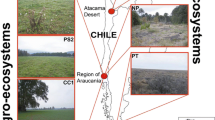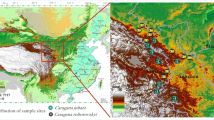Abstract
Plant growth-promoting rhizobacteria (PGPR) are common components of the rhizosphere, but their role in adaptation of plants to extreme environments is not yet understood. Here, we examined rhizobacteria associated with ancient clones of Larrea tridentata in the Mohave desert, including the 11,700-year-old King Clone, which is oldest known specimen of this species. Analysis of unculturable and culturable bacterial community by PCR-DGGE revealed taxa that have previously been described on agricultural plants. These taxa included species of Proteobacteria, Bacteroidetes, and Firmicutes that commonly carry traits associated with plant growth promotion, including genes encoding aminocyclopropane carboxylate deaminase and β–propeller phytase. The PGPR activities of three representative isolates from L. tridentata were further confirmed using cucumber plants to screen for plant growth promotion. This study provides an intriguing first view of the mutualistic bacteria that are associated with some of the world’s oldest living plants and suggests that PGPR likely contribute to the adaptation of L. tridentata and other plant species to harsh environmental conditions in desert habitats.


Similar content being viewed by others
References
Acuña JJ, Jorquera MA, Martínez OA, Menezes-Blackburn D, Fernández MT, Marschner P, Greiner R, Mora ML (2011) Indole acetic acid and phytase activity produced by rhizosphere bacilli as affected by pH and metals. J Soil Sci Plant Nutr 11:1–12
Blaha D, Prigent-Combaret C, Mirza MS, Moënne-Loccoz Y (2006) Phylogeny of the1−aminocyclopropane−1−carboxylic acid deaminase-encoding gene acdS in phytobeneficial and pathogenic Proteobacteria and relation with strain biogeography. FEMS Microbiol Ecol 56:455–470
Choudhary DK, Johri BN (2009) Interactionsof Bacillus spp. and plants−with special reference to induced systemic resistance (ISR). Microbiol Res 164:493–513
Glick BR (2005) Modulation of plant ethylene levels by the bacterial enzyme ACC deaminase. FEMS Microbiol Lett 251:1–7
Glick BR, Cheng Z, Czarny J, Duan J (2007) Promotion of plant growth by ACC deaminase-producing soil bacteria. Eur J Plant Pathol 119:329–339
Hontzeas N, Richardson AO, Belimov AA, Safranova VI, Abu-Omar MM, Glick BR (2005) Evidence for horizontal gene transfer (HGT) of 1−aminocyclopropane−1−carboxylate deaminase genes. Appl Environ Micro 71:7556–7558
Huang H, Shi P, Wang Y, Luo H, Shao N, Wang G, Yang P, Yao B (2009) Diversity of beta−propeller phytase genes in the intestinal contents of grass carp provides insight into the release of major phosphorus from phytate in nature. Appl Environ Microb 75:1508–1516
Iwamoto T, Tani K, Nakamura K, Suzuki Y, Kitagawa M, Eguchi M, Nasu M (2000) Monitoring impact of in situ biostimulation treatment on groundwater bacterial community by DGGE. FEMS Microbiol Ecol 32:129–141
Jorquera MA, Hernández M, Martínez O, Marschner P, Mora ML (2010) Detection of aluminium tolerance plasmids and microbial diversity in the rhizosphere of plants grown in acidic volcanic soil. Eur J Soil Biol 46:255–263
Jorquera MA, Crowley DE, Marschner P, Greiner R, Fernández MT, Romero D, Menezes-Blackburn D, Mora ML (2011) Identification of β–propeller phytase-encoding genes in culturable Paenibacillus and Bacillus spp. from the rhizosphere of pasture plants on volcanic soils. FEMS Microbiol Ecol 75:163–172
Kawai M, Matsutera E, Kanda H, Yamaguchi N, Tani K, Nasu M (2002) 16S ribosomal DNA-based analysis of bacterial diversity in purified water used in pharmaceutical manufacturing processes by PCR and denaturing gradient gel electrophoresis. Appl Environ Microb 68:699–704
May MR, Provance MC, Sanders AC, Ellstrand NC, Ross-Ibarra J (2009) A Pleistocene clone of Palmer's Oak persisting in southern California. PLoS One 4:e8346. doi:10.1371/journal.pone.0008346
McSpadden Gardener BB (2004) Ecology of Bacillus and Paenibacillus spp. in agricultural systems. Phytopathology 94:1252–1258
Pearce TA, Brock KV, Stills HF (1994) Comparative analysis of the 16 rRNA gene sequence of the putative agent of proliferative ileitis of Hamsters. Appl Environ Microbiol 44:832–835
Penrose DM, Glick BR (2003) Methods for isolating and characterizing ACC deaminase-containing plant growth-promoting rhizobacteria. Physiol Plant 118:10–15
Richardson AE, Simpson RJ (2011) Soil microorganisms mediating phosphorus availability update on microbial phosphorus. Plant Physiol 156:989–996
Tye AJ, Siu FKY, Leung TYC, Lim BL (2002) Molecular cloning and the biochemical characterization of two novel phytases from B. subtilis 168 and B. licheniformis. Appl Microbiol Biotechnol 59:190–197
Vasek FC (1980) Creosote bush: long-lived clones in the Mojave desert. Amer J Bot 67:246–255
Wang C, Ramette A, Punjasamarnwong P, Zala M, Natsch A, Moenne-Loccoz Y, De’Fago G (2001) Cosmopolitan distribution of phlD-containing dicotyledonous crop-associated pseudomonads of worldwide origin. FEMS Microbiol Ecol 37:105–116
Yang J, Kloepper JW, Ryu C-M (2008) Rhizosphere bacteria help plants to tolerate abiotic stress. Trends Plant Sci 14:1–4
Acknowledgment
The International Human Frontier Science Program Organization (HFSP), US−Israel Binational Agricultural Research and Development (BARD), FONDECYT Iniciación no. 11080159, and MEC−CONICYT no. 80110001.
Author information
Authors and Affiliations
Corresponding author
Rights and permissions
About this article
Cite this article
Jorquera, M.A., Shaharoona, B., Nadeem, S.M. et al. Plant Growth-Promoting Rhizobacteria Associated with Ancient Clones of Creosote Bush (Larrea tridentata). Microb Ecol 64, 1008–1017 (2012). https://doi.org/10.1007/s00248-012-0071-5
Received:
Accepted:
Published:
Issue Date:
DOI: https://doi.org/10.1007/s00248-012-0071-5




